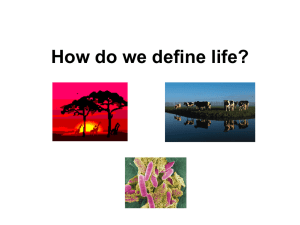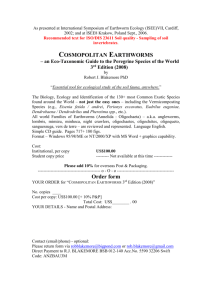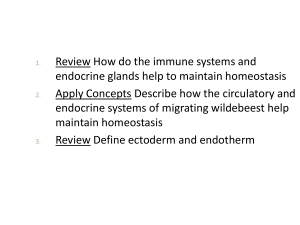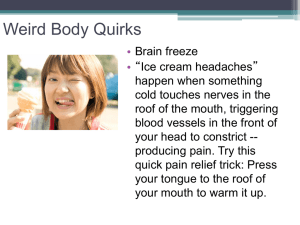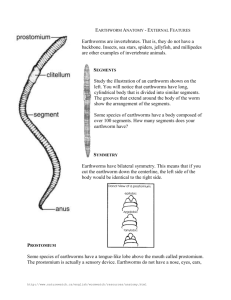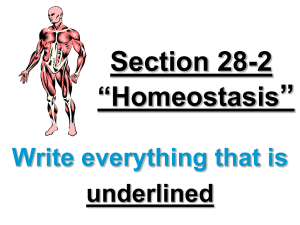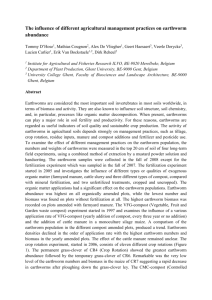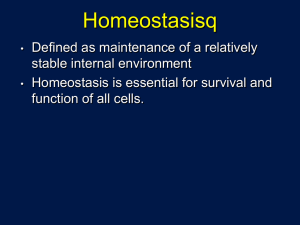Earthworm Dissection
advertisement
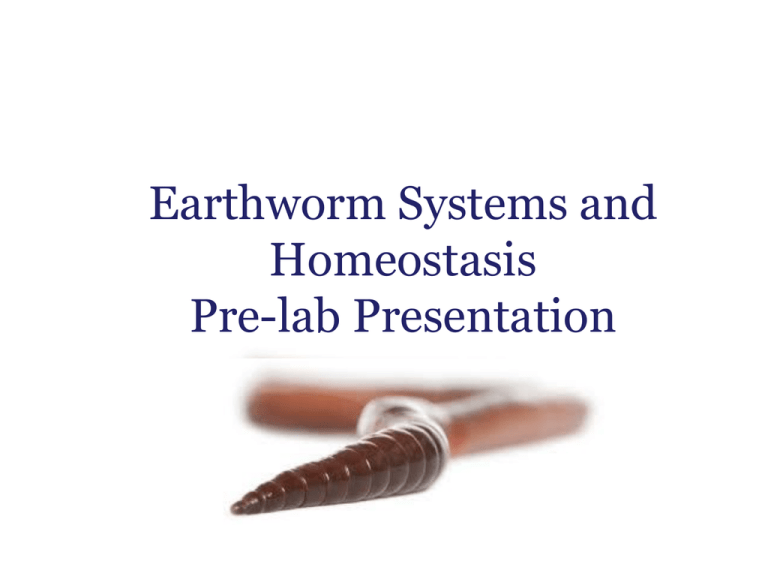
Earthworm Systems and Homeostasis Pre-lab Presentation Objectives: 1. Become familiar to all major earthworm systems for maintaining homeostasis. 2. Understand how the earthworm fits into the world. 3. Use this informative presentation to design and conduct a well designed experiment to test homeostasis in an Earthworm. All living things must maintain a relatively stable internal environment to survive. • The term used to describe this is "homeostasis." Living things carry out different essential functions in order to accomplish this task. • Multi-cellular organisms have “systems” that work together to maintain this stable environment. For example when you run your body is placed under severe stress. Various systems will start to work overtime keeping your body alive • Your heart starts beating faster and your breathing increases. Your body is trying to deliver oxygen and take away carbon dioxide (respiratory waste) from working muscles etc. Your skin starts to sweat reducing the excess body heat created by the activity. • Without your body systems working together your systems will fail and death would ensue. There are many more system accommodations that occur as you run or engage your body in different activities. • Multicellular organisms maintain homeostasis differently. Compare the differences between warm blooded and cold blooded organisms. To adjust body temperature insects or reptiles will move their body to a location that will ether warm or cool their body depending on their needs. Regulation and Conforming • A regulator uses internal control mechanisms to moderate internal change in the face of external, environmental fluctuation. • A conformer allows its internal conditions to vary with certain external changes. • Animals may regulate some environmental variable while conforming to others. Feedback control maintains the internal environment in many animals. • Organisms use homeostasis to maintain a “steady state” or internal balance regardless of external environment. • In mammals body temperature, blood pH, and glucose concentration are each maintained at a constant level. • Animals manage their internal environment by regulating or conforming to the external environment. Maintenance of homeostasis • The dynamic equilibrium of homeostasis is maintained by negative feedback, which helps to return a variable to a normal range. • Most homeostatic control systems function by negative feedback, where buildup of an end product shuts the system off. • Positive feedback amplifies a stimulus and does not usually contribute to homeostasis in animals. Regulator response to cold Regulator response to warmth Adjusting to seasonal changes • Organisms can use homeostasis to adjust to changes in external environment, a process called acclimatization. • Acclimatization to seasonal temperatures in some animals may include changes in insulation layers, such as thicker fur in winter and shedding in summer. • In ectotherms, cellular adjustments can occur. Concentrations of lipids in cellular membranes can increase or decrease.. • Some species produce antifreeze. compounds that prevent freezing of cellular tissues. • Antifreeze proteins are a class of proteins that interact with cellular membranes to prevent freezing, allowing survival in subzero temperatures. Coordination and Control • Control and coordination within a body depend on the endocrine and nervous systems. • The endocrine system transmits chemical signals called hormones to receptive cell throughout the body. • A hormone may affect one or more regions throughout the body. • Hormones are relatively slow acting, but can have long-lasting effects. • The nervous system by contrast carries messaged to specific regions in an organism via specialized nervous cells. Below are a few examples of various systems found in multicellular organisms under homeostatic control. • • • • • • • Digestive /Feeding Response /Nervous Movement Circulatory Respiratory Reproductive Excretion • Single celled organisms do not have systems because they are only made of one cell. Thus each cell must carry out all of these functions without relying on tissues, organs and organ systems (ex. bacteria, yeast, and most protists). Classification of Earthworm Kingdom Animalia: Multicellular eukaryote, heterotrophic Phylum Annelida: body made of many segments separated by a septum. Two body openings and a closed circulatory system. Ex. Earthworms, marine worms, leeches etc. Class Oligochaeta: lack appendages and very few bristles. The can be terrestrial or found in fresh water External Anatomy The setae are structures we cannot visualize with the naked eye. If you rub your fingers along the ventral surface it feels like sand paper. This sensation is a result of the little bristle like structures called setae. These bristles give them traction as they move through their tunnels and along the surface of the soil. Feeding (digestive), Earthworms have a fleshy projection on the anterior end called the prostomium. This structure covers the mouth. The mouth leads into a muscular pharynx that pumps food into a storage organ called the crop. Just posterior to the crop is a thick-walled, highly muscularized gizzard. Small rocks (grit) in the gizzard help to grind food before it is moves into the intestine where the nutrients from the food is absorbed. After absorption solid waste is eliminated through the anus. The solid waste of earthworms are called castings. Worm castings are highly sought after because of their concentrations of nitrogen, phosphorus, potassium, micronutrients and beneficial bacteria. Worm feces is a fantastic fertilizer and very expensive. Earthworms also help to till / mix the soil as they burrow through the ground. As a result they leave a network of tiny holes and spaces that help water and air get to plant roots. These spaces are critical niches for bacteria to colonize and decompose organic debris as well as fix nitrogen (nitrogen fixation). The intestine extends from the posterior end of the gizzard and continues until it reaches the anus. Respiration, (respiratory system) Earthworms secrete a thin surface film of mucus to keep them moist so oxygen and carbon dioxide can diffuse through the body wall. Worms do not have lungs or gills like some organisms. Remember that living things accomplish each of the tasks necessary to maintain homeostasis differently. All living things MUST have a way to deal with these requirements Circulation, (circulatory) Earthworms have five simple hearts located just anterior to the crop and posterior to the pharynx. These are very simple hearts / vessels that pump blood throughout the earthworm. Earthworm blood is red because it has hemoglobin. Remember that hemoglobin is a protein that binds oxygen. There are two relatively large blood vessels that run along the top (dorsal) and along the bottom (ventral). There are small vessels that connect the two. The earthworms circulatory system is considered to be a closed system because the blood circulates within a network of vessels. An open system has spaces or cavities filled with blood that surrounds body organs. The blood in these cavities is picked up by vessels and circulated throughout the organism. Don’t forget that earthworms have a closed circulatory system. Hearts Excretion (excretory system) Solid waste passing though the intestine is eliminated through the posterior opening called the anus. Cellular waste is excreted in a different way. Remember all cells excrete cellular waste (nitrogenous). When waste products accumulate inside body tissues they become toxic and must be removed or the creature will die. To eliminate cellular waste metanephridia remove toxins keeping the cellular landscape free of excess garbage. The metanephridia are connected to openings called nephridiopores. The cellular waste is excreted from these openings. Response (nervous) The earthworm, as well as most annelids, have a well developed nervous system consisting of a brain and many nerve cords. You can see from this image that the ventral nerve cord is connected to the brain Movement (skeletal and muscular) Earthworms alternately contract their longitudinal (shortens) and circular (elongates) muscles to move. Reproduction, (reproductive system) Although earthworms are monecious, they undergo cross-fertilization during copulation. During copulation sperm cells are released from the seminal vesicles and stored in the seminal receptacles of the opposite earthworm. The clitellum slides over the anterior segments and picks up eggs from the oviducts in the 14th segment and sperm as it slides over the anterior end of the worm to form the egg cocoon.
